Golden Eagle
Aquila Chrysaetos
Their calls sound like high-pitched screams, but they are quiet most of the time.
Advertisement
Golden Eagle Scientific Classification
- Kingdom
- Animalia
- Phylum
- Chordata
- Class
- Aves
- Order
- Accipitriformes
- Family
- Accipitridae
- Genus
- Aquila
- Scientific Name
- Aquila Chrysaetos
Read our Complete Guide to Classification of Animals.
Golden Eagle Conservation Status
Golden Eagle Facts
- Prey
- rabbits, hares, squirrels, prairie dogs, fish, cranes, swans, badgers, and carrion (dead animals).
- Name Of Young
- Eaglets
- Group Behavior
- Mainly solitary
- Fun Fact
- Their calls sound like high-pitched screams, but they are quiet most of the time.
- Estimated Population Size
- 85,000 to 160,000
- Biggest Threat
- Climate change, power lines, and pollution
- Most Distinctive Feature
- Long, broad wings
- Distinctive Feature
- Small heads, long tails
- Wingspan
- 7 feet
- Incubation Period
- 41 to 45 days
- Age Of Independence
- 60 to 70 days
- Habitat
- Mountains, canyons, riverside cliffs
- Predators
- Coyotes, wolverines, and bears
- Diet
- Carnivore
- Lifestyle
- Diurnal
- Type
- Bird
- Common Name
- golden eagle
- Number Of Species
- 6
- Location
- North America, Africa, Europe, Asia
- Average Clutch Size
- 2
- Nesting Location
- Cliff ledges or large trees
- Migratory
- 1
View all of the Golden Eagle images!
“The golden eagle is one of the largest birds in North America.”
Summary
The golden eagle (Aquila chrysaetos) lives in the northern hemisphere across four continents and over 70 countries. It inhabits semi-open areas with rocky ledges and cliffs and spends its days soaring low to the ground in search of prey. This species is ferocious and can kill and eat animals twice its size. Discover this unique bird of prey, including where it lives, what it eats, and how it behaves.
5 Amazing Golden Eagle Facts
- Golden eagles are one of the largest birds in North America and feature a seven-foot wingspan.
- They are incredibly fast and agile, reaching speeds up to 200 Mph!
- Males and females form long-term pairs bonds and return to the same nesting site for several years.
- Their calls sound like high-pitched screams, but they are quiet most of the time.
- Mated pairs hunt together and form coordinated attacks.
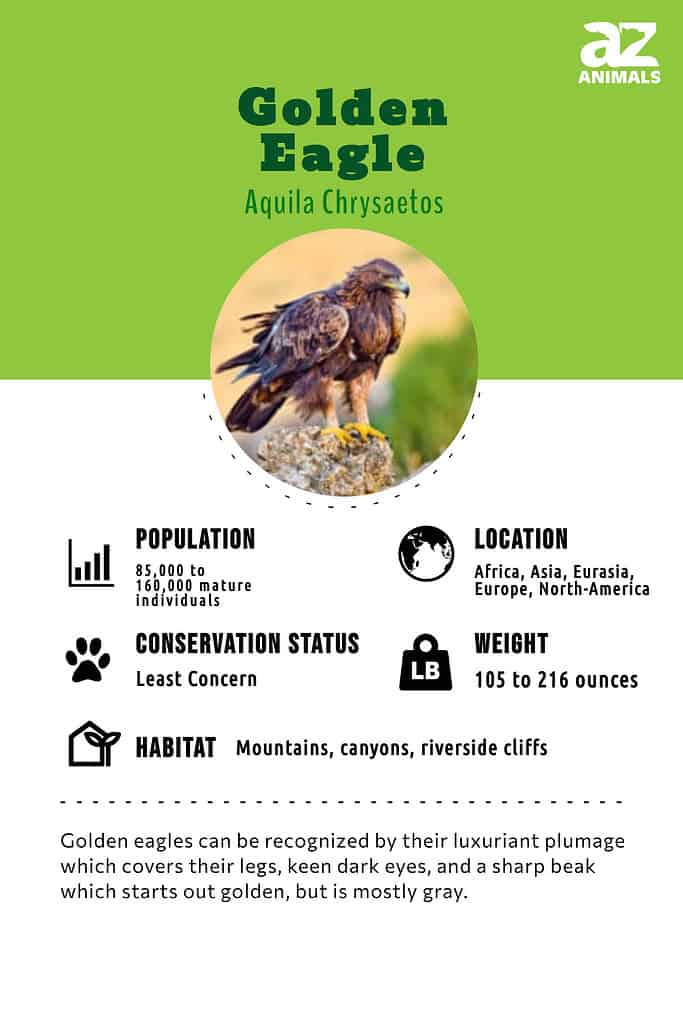
Where to Find the Golden Eagle

The Golden Eagle prefers to nest on cliff ledges or in regions with tall trees
©MehmetO/Shutterstock.com
The golden eagle lives across four continents (North America, Africa, Europe, and Asia) in over 70 countries, including Canada, the United States, the United Kingdom, Russia, and China. In North America, they breed in Alaska and Canada and winter across most of the United States. Some populations live year-round on the west side of the US. You will find these birds in open or semi-open habitats, including mountains, canyons, riverside cliffs, and rimrock. They nest on cliff ledges and vegetated areas with tall trees.
Golden Eagle Nest
They nest on cliff ledges or large trees. It’s built by both sexes and consists of a bulky platform made of sticks, and they line the insides with weeds, grass, leaves, and moss. They reuse the same nesting sites for multiple years, adding more material each season.
Scientific Name

There are six subspecies of golden eagle.
©Martin Mecnarowski/Shutterstock.com
The golden eagle (Aquila chrysaetos) is from the Accipitridae family and contains diurnal birds of prey with strongly hooked bills and varied diets. The Aquila genus is a group of true eagles. The name is Latin for “eagle” and “dark in colour.” Chrysaetos is Ancient Greek for “gold” and “eagle.” There are six recognized golden eagle subspecies.
Size, Appearance, & Behavior
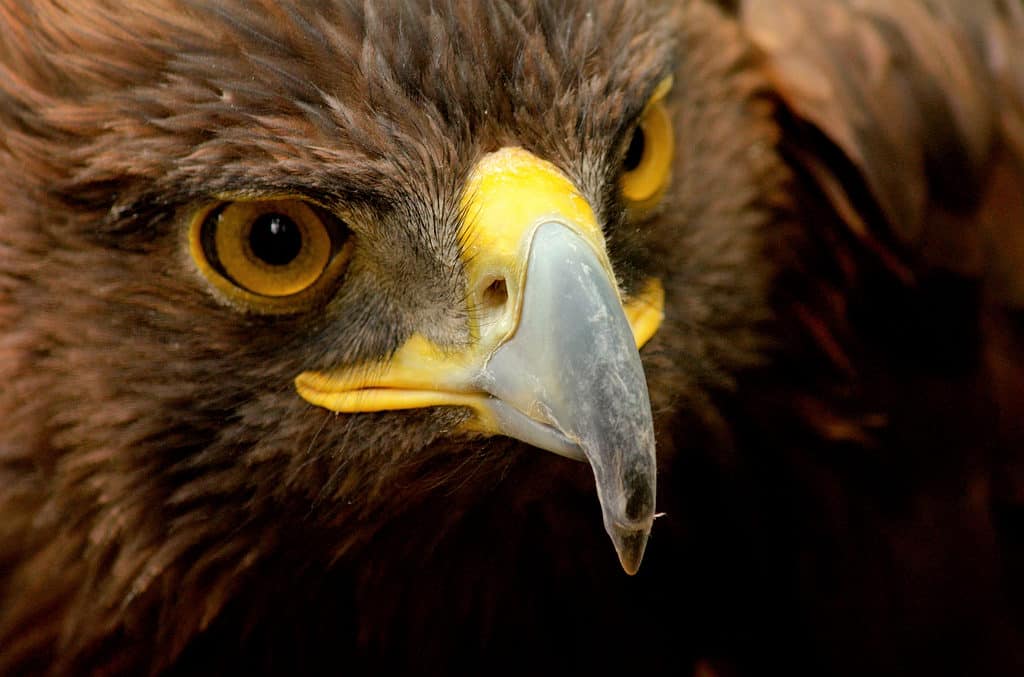
Golden eagles have a wingspan of seven feet and are capable of growing to 33 inches in length
©iStock.com/Paco Adame
Golden eagles are one of the largest birds in North America, measuring 26 to 33 inches long and weighing 105 to 216 ounces, with a 72 to 86-inch (7 feet) wingspan. They have relatively small heads, long tails, and long, broad wings. Adults are dark brown with a golden hue on the back of their heads and necks, and both males and females look similar. Their young are distinguishable by the white patches on their wings and at the base of their tails.
These birds are primarily solitary, except for breeding pairs. They may occasionally bathe in groups or roost together in freezing weather. You often find them soaring or gliding low to the ground with their wings lifted in a V-shape. They are incredibly agile and fast, reaching speeds of almost 200 Mph. They are typically quiet birds, but when they do make calls, they sound like high-pitched screams and squeals.
Migration Pattern and Timing
Golden eagles are short to medium-distance migrants, and some populations are residents. Most golden eagles in Europe, Africa, and Asia stay in their environments year-round. But those who breed in Sweden and Belarus will migrate to warmer areas during winter. Eagles in North America have a split population. Those on the west of the United States stay in their environments year-round, while others breed in Alaska and Northern Canada and migrate into the United States during winter.
Evolution
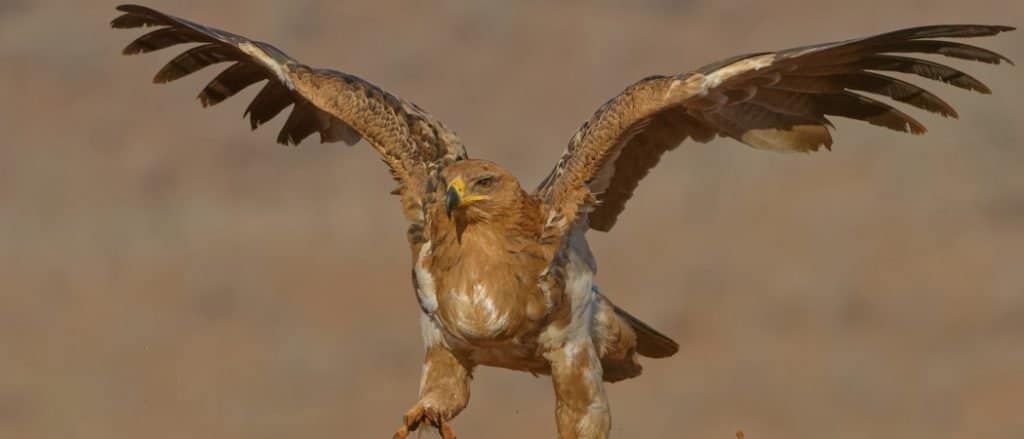
The tawny eagle also belongs to the Aquila genus and is also closely related to the golden eagle
©Tobie Oosthuizen/Shutterstock.com
Its membership of the Aquila genus means the golden eagle gets to be considered a “true eagle”. Other members of that rather illustrious group include the tawny eagle (Aquila rapax), the wedge-tailed eagle (Aquila audax), and the Steppe eagle (Aquila nipalensis).
As a member of the Accipitridae, the golden eagle is also related to hawks, harriers, kites, and even vultures. Its membership of that wider family also means it belongs to the order Accipitriformes.
This group of birds of prey and carrion eaters appeared during the Eocene era, i.e., 34 – 55.6 million years ago. It also contains the following families which are also distant relatives of the golden eagle:
- Cathartidae: Included in this family are the Black vulture, the turkey vulture, and the Andean condor.
- Pandionidae: This family is made up solely of ospreys.
- Sagittariidae: The secretary bird is the sole member of this family.
Types
There are six subspecies of the golden eagle, including:
- The European golden eagle (Aquila chrysaetos chrysaetos): This subspecies is found throughout Europe and even as far as Kazakshstan and Iran.
- The Iberian golden eagle (Aquila chrysaetos homeyeri): This subspecies calls the Iberian Peninsula home. It can also be found in Ethiopia, Morocco, Tunisia, Kazakhstan, and Iran.
- The Asian golden eagle (Aquila chrysaetos daphanea): .The range of the Asian golden eagle includes Bhutan, China, Iran, Kazakhstan, and Myanmar.
- The Japanese golden eagle (Aquila chrysaetos japonica): The range of this subspecies includes the Japanese islands of Hokkaido, Honshu, and Kyushu, as well as Korea.
- The North American golden eagle (Aquila chrysaetos canadensis): This subspecies can be found in Alaska, Canada, Mexico, and the Western United States.
- The Siberian golden eagle (Aquila chrysaetos kamtschatica): This subspecies can be found in Russia, western Siberia, and northern Mongolia.
Diet

Golden eagles are strictly carnivores who eat anything they can get their talons on.
What Does the Golden Eagle Eat?
They eat rabbits, hares, squirrels, prairie dogs, fish, cranes, swans, badgers, and carrion (dead animals). These eagles can take down creatures much bigger than them, including coyotes, deer, livestock, seals, mountain goats, bobcats, and bighorn sheep. They will even rob bird nests and steal food from other birds. Most of the time, they use aerial attacks to strike their prey, but occasionally they hunt from the ground, flapping their wings as they run. Black-tailed jackrabbits are one of their favorite foods, and mated pairs will hunt this species together with coordinated attacks. One will distract the rabbit as the other goes in for the kill.
Predators, Threats, and Conservation Status
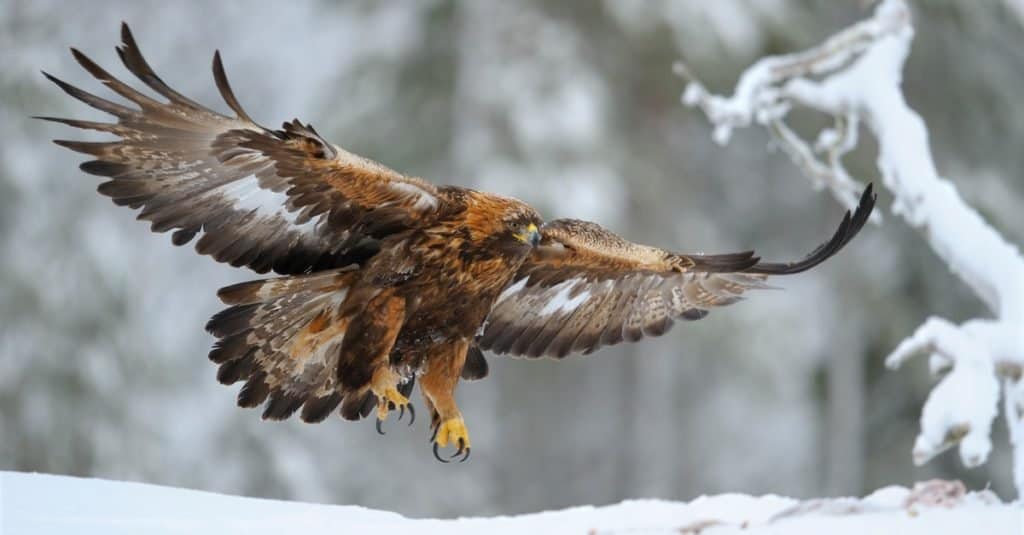
Golden eagles were the targets of persecution during the 1800s and are still at risk of being shot or trapped today
©Vladimir Kogan Michael/Shutterstock.com
The IUCN lists the golden eagle as LC or “least concern.” Due to its extensive range and huge, stable population, this species does not meet “threatened” thresholds. This eagle was heavily persecuted in the 19th century, but that threat has significantly diminished. However, they do still suffer from trapping, shooting, and poisoning. While they don’t currently have any severe threats facing their population, these birds still endure the effects of climate change, the agricultural industry, power lines, and pollution.
What Eats the Golden Eagle?

In spite of their status as birds of prey, golden eagles may fall victim to the unwelcome attention of bears
©Roonie_70/Shutterstock.com
Golden eagles are birds of prey, and adults have no natural predators. But they may occasionally be harassed by crows, jays, and raptors. Eaglets are not so fortunate and can fall victim to coyotes, wolverines, and bears. Thankfully, this is not too common. Golden eagles are ferocious predators who can take down creatures bigger than them, such as wolves and deer. This species is known to be more aggressive than a bald eagle and will use its sharp talons to tear flesh as it rapidly descends on intruders. They may even use their strong beaks to inflict painful bites.
Reproduction, Young, and Molting
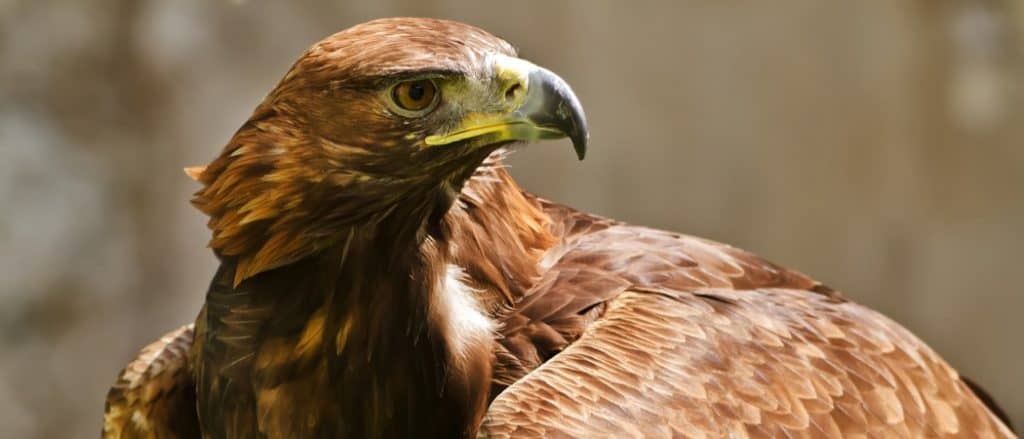
©Michal Ninger/Shutterstock.com
Golden eagles are monogamous and remain with the same mate for several years or life. They perform courtship displays, which include aerial acrobatics like circling and diving. Females lay one to four eggs, but two are typically the average. The eggs are white with brown markings, and both sexes assist in incubation, which lasts 41 to 45 days. After hatching, females remain with the nestlings while the males hunt and bring food. The young can fly on their own for around 60 to 70 days and don’t join the breeding population until four years old. These eagles have long lifespans and can live between 20 to 30 years.
Population
The global golden eagle population is estimated to number 85,000 to 160,000 mature individuals. Over the last 40 years, their numbers have been stable in North America and steadily increasing in Europe. Their population does not suffer from extreme fluctuations or fragmentations.
Similar Animals:
View all 170 animals that start with GGolden Eagle FAQs (Frequently Asked Questions)
Where do golden eagles live?
The golden eagle lives across four continents (North America, Africa, Europe, and Asia) in over 70 countries, including Canada, the United States, the United Kingdom, Russia, and China.
How big are golden eagles?
Golden eagles are one of the largest birds in North America, measuring 26 to 33 inches long and weighing 105 to 216 ounces, with a 72 to 86-inch (7 feet) wingspan.
Are golden eagles social?
These birds are primarily solitary, except for breeding pairs. They may occasionally bathe in groups or roost together in freezing weather.
How fast are golden eagles?
They are incredibly agile and fast, reaching speeds of almost 200 Mph.
What do golden eagles eat?
They eat rabbits, hares, squirrels, prairie dogs, fish, cranes, swans, badgers, and carrion (dead animals). These eagles can take down creatures much bigger than them, including coyotes, deer, livestock, seals, mountain goats, bobcats, and bighorn sheep.
What threatens the golden eagle?
While they don’t currently have any severe threats facing their population, these birds still endure the effects of climate change, the agricultural industry, power lines, and pollution.
How aggressive are golden eagles?
This species is known to be more aggressive than a bald eagle and will use its sharp talons to tear flesh as it rapidly descends on intruders. They may even use their strong beaks to inflict painful bites.
Thank you for reading! Have some feedback for us? Contact the AZ Animals editorial team.
Sources
- IUON Red List / Published May 27, 2021 / Accessed September 29, 2022
- Birds of North America / Accessed September 29, 2022
- The Golden Eagle / Jeff Watson / Accessed September 29, 2022


















